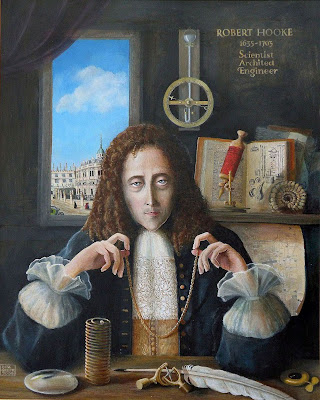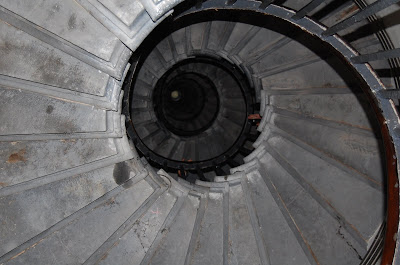
This is the Monument, built between 1671 and 1677 to commemorate the Great Fire of London.

Climb the 311 steps to the viewing platform – as I did on Tuesday – and as well as the nice views you get a certificate. But the Monument is more than just a memorial to the fire. It was built by Christopher Wren and Robert Hooke – members of the Royal Society.

This is Hooke in a modern painting by Rita Greer. He deduced the wave theory of light and the law of elasticity – which is named after him. He was a pioneer of surveying and map-making. He wasn't a little guy in science. But it was to Hooke that Isaac Newton wrote his famous remark, “If I have seen further [than others] it is only by standing on the shoulders of giants”.
It's a back-handed compliment: Hooke had come close to deducing – before Newton – that gravity follows an inverse square law and that this explains the movement of the planets. Newton developed Hooke's ideas but – Hooke felt – didn't credit him sufficiently. So perhaps Newton's remark is rubbing Hooke's nose in it: the “giant” Newton was standing on had a stoop and may have been a hunchback.
The remark though, is often seen as a testament to scientific endeavour – scientists and mathematicians building on the work of their peers and predecessors. That's why it's engraved on £2 coins (though perhaps that's not the best example of engineering prowess - the coin also shows a a series of cogs in a circle, but there's an odd number so the machinery would not be able to turn as it would pull against itself). As Jacob Bronowski said in The Ascent of Man,
“Year by year, we devise more precise instruments with which to observe nature with more fineness.”Jacob Bronowski, The Ascent of Man (1973), p. 356.

This is Hooke's drawing of a flea from Micrographia, published in 1665. It was the Royal Society's first major book – and the first scientific bestseller.
Micrographia isn't just about looking at tiny things through a microscope. It includes drawings of distant objects, such as the Moon and the star cluster Pleiades (see below). Large and small, these observations changed our view of the universe and our place in it. Theories on gravity needed more and better data about the stars – that meant better telescopes.
In principle, the mathematics of improving a telescope are simple. A lens defracts the light so when you look through it things seem bigger. Look through two lenses at once and they're bigger still. The easiest way to do that is to place a lens at either end of a tube. Increase the distance between the two lenses and you increase the magnification. So to really study the stars, Hooke needed a really long tube...

The Monument was built as a zenith telescope – one that looks straight up. By looking at a fixed star, Hooke hoped to gain evidence that the Earth moved round the Sun. Maths provided the theory: now Hooke would prove it for certain.

The spiral staircase inside means there's a clear view all the way up to the top of the Monument, where a trapdoor would open to reveal the sky. To make the telescope even longer, Hooke worked down in the small cellar – you can see it through the grill in the floor as you begin your climb.
Sadly, though, the telescope didn't work. The vibration from London's traffic meant the readings were never accurate enough. The mathematics of lenses is simple, but the reality is more complicated.

The Monument was used for other experiments. The steps were designed to be used in pressure studies, and are all exactly six inches high.
Hooke continued to study the stars. He worked on the design of the Royal Observatory in Greenwich, the first purpose-built research facility in the country. And the more we've discovered since Hooke about space and the position of the stars, the more we come back to the problems that vexed him.

This is me at the 76-metre Lovell radio telescope at Jodrell Bank. It's the third-largest steerable radio telescope in the world. But, like the Monument, size isn't everything. Just beside it is a 38-metre Mark II dish which turned out to be much more accurate and better at listening to higher frequencies.

There's also the accuracy of the observations we make. “Astronomical instruments have been improved,” says Jacob Bronowski.
“We look at the position of a star as it was determined then and now, and it seems to us that we are closer and closer to finding it precisely.

“But when we actually compare our individual observations today, we are astonished and chagrined to find them as scattered within themselves as ever. We had hoped that the human errors would disappear ... but it turns out that the errors cannot be taken out of the observations. And that is true of stars, of atoms, or just ... hearing the report of somebody's speech.”Ibid., p. 358.
Bronowski called this,
“the crucial paradox of knowledge ... we seem to be running after a goal which lurches away from us to infinity.”Since Newton, we tend to assume that the laws of nature are regular, simple and mathematical, and that any deviation from that regularity in our measurements is likely to be our own error. Mathematics can help clarify our observations.Ibid., p. 356.
“When an observer looks at a star, he knows there is a multitude of causes for error. So he takes several readings, and he hopes, naturally, that the best estimate of the star's position is the average – the centre of the scatter.”Ibid., p. 358.

Johann Gauss (1777 to 1855), sometimes known as the “Prince of Mathematicians”,
“pushed on to ask what the scatter of the errors tells us. He devised the Gaussian curve in which the scatter is summarised by the deviation, the spread, of the curve. And from this came a far-reaching idea: the scatter marks an area of uncertainty.

We are not sure that the true position is the centre. All we can say is that it lies in the area of uncertainty, and that the area is calculable from the observed scatter of the individual observations.”Ibid.

The folly of the Monument is not that it didn't work as a telescope but that Hooke, looking up through it from his cellar, was looking for certainty, for proof of the mathematical theory. It's not that maths or physics are uncertain, but measurement is. Bronowski described measurement as "personal". Maths doesn't prove with certainty, but it can show the extent of what we don't know.
(Thanks to Simon Belcher, Danny Kodicek and Marek Kukula who looked this over, and Marcus du Sautoy who pointed out the cogs on £2 coins.)








1 comment:
I must be a moron, but I never realized you could climb up Monument!
Post a Comment